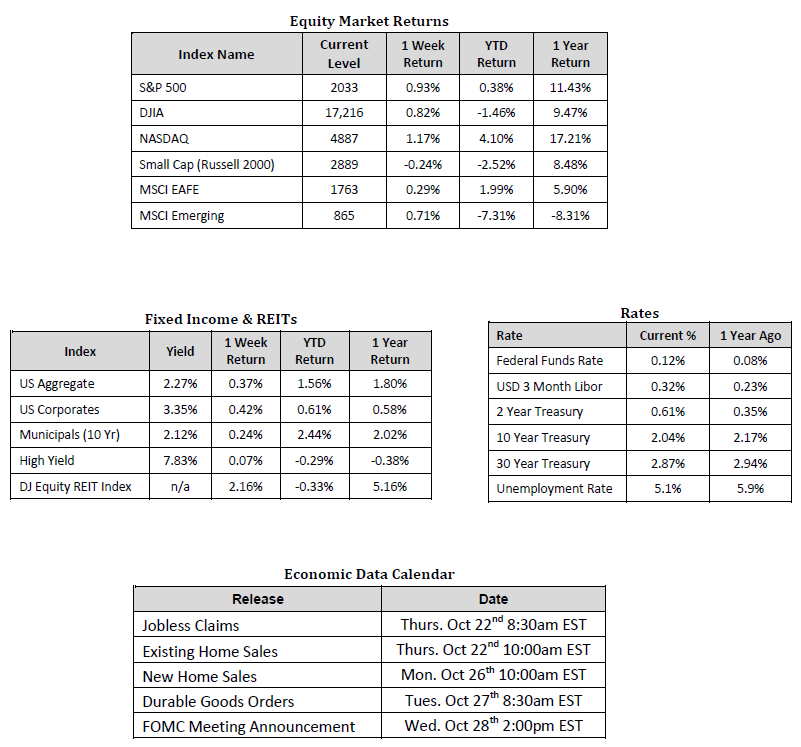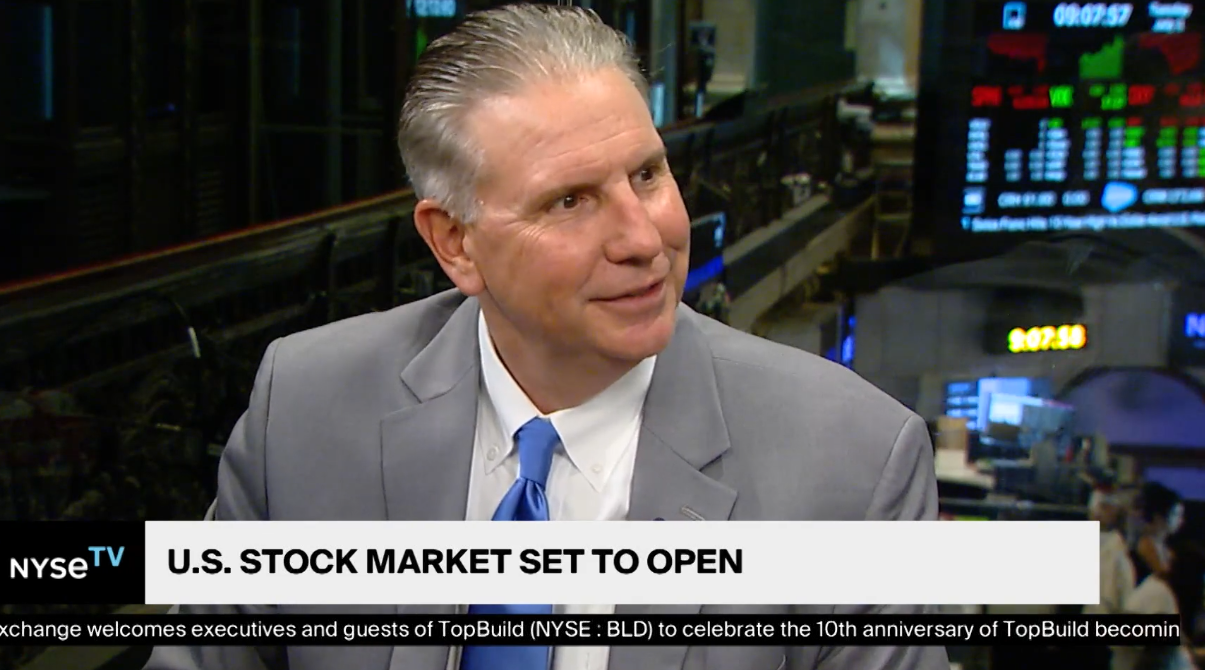
Economic Data Stabilizes ahead of Fed Meeting
Market Overview

Sources: Equity Market, Fixed Income and REIT returns from JP Morgan as of 10/16/15. Rates and Economic Calendar Data from Bloomberg as of 10/19/15.
Happening Now
Economic data last week pointed to a continuation of the slow economic growth that has characterized the global economy following the great recession of 2008 – 2009. The release of the Fed Beige Book ahead of the Federal Open Market Committee’s October 27/28 meeting painted a slightly negative picture. According to Bloomberg.com, “Only three of 12 districts are describing growth as “moderate”, and that’s as good as it gets. Six are using the word “modest” with two reports of immediate slowing and even one report of contraction from the energy-hit Kansas City district.” Inflation data furthered the case for no immediate rate hike during the October meeting (though an initial rate hike by the end of the year is still likely) with the Producer Price Index and the Consumer Price Index contracting -0.5% and -0.2% respectively. It should be noted, however, with regards to inflation that if you remove volatile food and energy prices the Consumer Price Index posted a year-over-year increase of 1.9%.
Lack of inflation and slow growth are nothing new to this market and stocks around the world finished last week mostly higher. The S&P 500 Index posted a 0.93% weekly gain, the MSCI EAFE Index (measuring international developed market stocks) rose 0.29% and the MSCI EM Index (measuring international emerging market stocks) gained 0.71%. The S&P 500 Index has now risen close to 6% this quarter alone despite an earnings season that is expected show net income fell an average of -4.6% over last year’s third quarter. Following a quarter that saw a contraction in this U.S. Large Cap stock-oriented index of almost 6.5%, volatility to the upside is now benefiting U.S. Large cap stock investors.
There are a number of headwinds that still face the U.S. and global economies including uncertainties surrounding the actual strength of the Chinese economy, U.S. Fiscal policy, the upcoming U.S. Presidential election in 2016 and the divergence in central bank monetary policies. For investors, we believe that it is prudent to consider the near-term market environment but long term success is still likely to be determined more from an implemented asset allocation strategy than from the ability to time the market or select “under-valued” companies.
Important Information and Disclaimers
Disclosures: Hennion & Walsh is the sponsor of SmartTrust® Unit Investment Trusts (UITs). For more information on SmartTrust® UITs, please visit www.smarttrustuit.com. The overview above is for informational purposes and is not an offer to sell or a solicitation of an offer to buy any SmartTrust® UITs. Investors should consider the Trust’s investment objective, risks, charges and expenses carefully before investing. The prospectus contains this and other information relevant to an investment in the Trust and investors should read the prospectus carefully before they invest.
Investing in foreign securities presents certain risks not associated with domestic investments, such as currency fluctuation, political and economic instability, and different accounting standards. This may result in greater share price volatility. These risks are heightened in emerging markets.
There are special risks associated with an investment in real estate, including credit risk, interest rate fluctuations and the impact of varied economic conditions. Distributions from REIT investments are taxed at the owner’s tax bracket.
The prices of small company and mid cap stocks are generally more volatile than large company stocks. They often involve higher risks because smaller companies may lack the management expertise, financial resources, product diversification and competitive strengths to endure adverse economic conditions.
Investing in commodities is not suitable for all investors. Exposure to the commodities markets may subject an investment to greater share price volatility than an investment in traditional equity or debt securities. Investments in commodities may be affected by changes in overall market movements, commodity index volatility, changes in interest rates or factors affecting a particular industry or commodity.
Products that invest in commodities may employ more complex strategies which may expose investors to additional risks.
Investing in fixed income securities involves certain risks such as market risk if sold prior to maturity and credit risk especially if investing in high yield bonds, which have lower ratings and are subject to greater volatility. All fixed income investments may be worth less than original cost upon redemption or maturity. Bond Prices fluctuate inversely to changes in interest rates. Therefore, a general rise in interest rates can result in the decline of the value of your investment.
Definitions
MSCI- EAFE: The Morgan Stanley Capital International Europe, Australasia and Far East Index, a free float-adjusted market capitalization index that is designed to measure developed-market equity performance, excluding the United States and Canada.
MSCI-Emerging Markets: The Morgan Stanley Capital International Emerging Market Index, is a free float-adjusted market capitalization index that is designed to measure the performance of global emerging markets of about 25 emerging economies.
Russell 3000: The Russell 3000 measures the performance of the 3000 largest US companies based on total market capitalization and represents about 98% of the investible US Equity market.
ML BOFA US Corp Mstr [Merill Lynch US Corporate Master]: The Merrill Lynch Corporate Master Market Index is a statistical composite tracking the performance of the entire US corporate bond market over time.
ML Muni Master [Merill Lynch US Corporate Master]: The Merrill Lynch Municipal Bond Master Index is a broad measure of the municipal fixed income market.
Investors cannot directly purchase any index.
LIBOR, London Interbank Offered Rate, is the rate of interest at which banks offer to lend money to one another in the wholesale money markets in London.
The Dow Jones Industrial Average is an unweighted index of 30 “blue-chip” industrial U.S. stocks.
The S&P Midcap 400 Index is a capitalization-weighted index measuring the performance of the mid-range sector of the U.S. stock market, and represents approximately 7% of the total market value of U.S. equities. Companies in the Index fall between S&P 500 Index and the S&P SmallCap 600 Index in size: between $1-4 billion.
DJ Equity REIT Index represents all publicly traded real estate investment trusts in the Dow Jones U.S. stock universe classified as Equity REITs according to the S&P Dow Jones Indices REIT Industry Classification Hierarchy. These companies are REITSs that primarily own and operate income-producing real estate.



